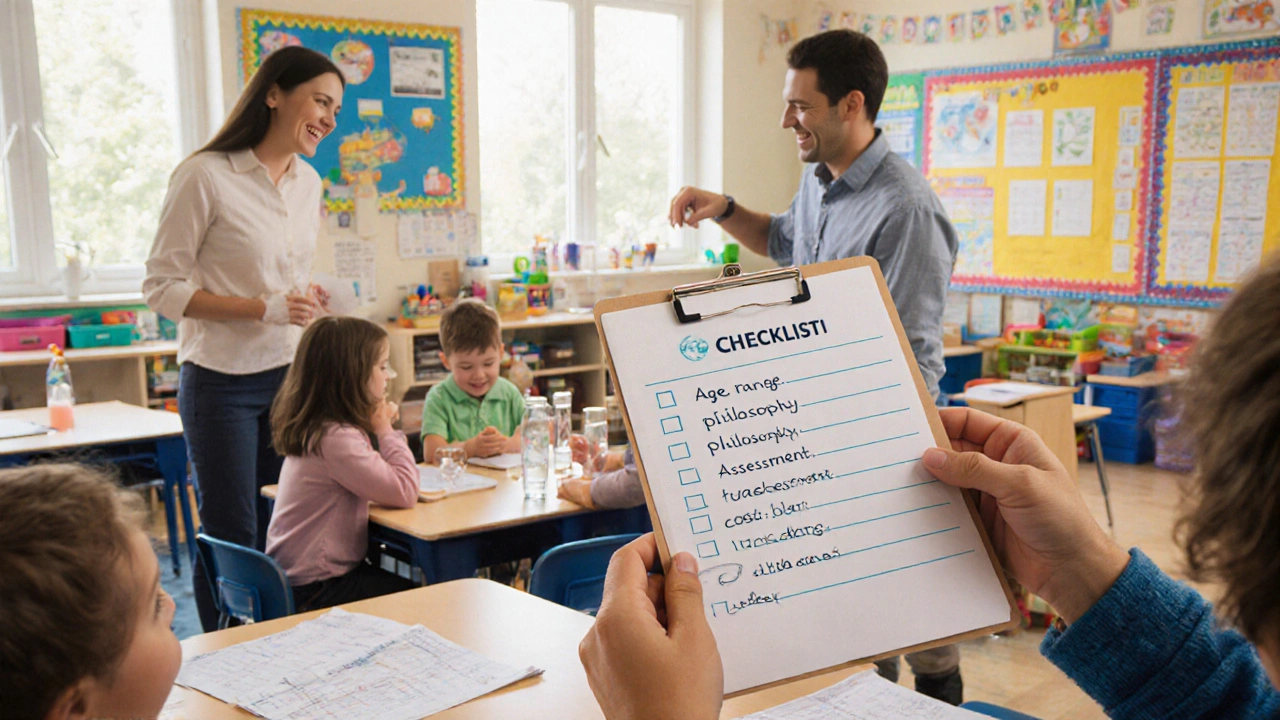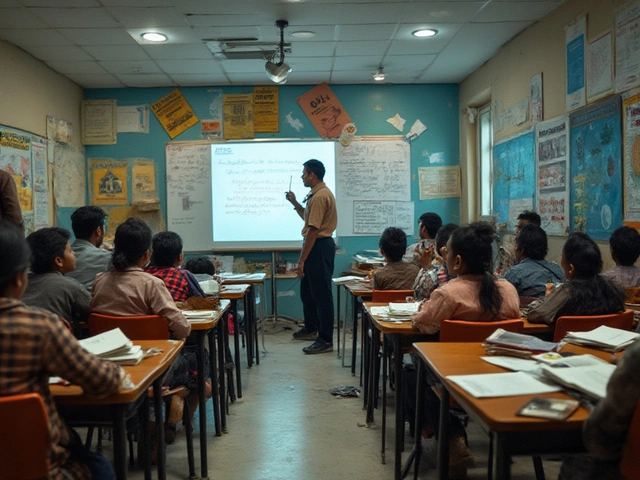
Curriculum Match Calculator
This tool helps you evaluate which primary school curriculum best matches your child's learning style and your family's priorities. Based on the article, select your top 3 priorities and rate how well each curriculum meets them.
Your Priorities
Select your top 3 priorities (choose 3):
Rate Each Curriculum
Rate each curriculum from 1-5 on how well it matches your selected priorities (5 = best match, 1 = poor match)
Key Takeaways
- Four main curriculum families dominate primary education: national, International Baccalaureate, Montessori/Waldorf, and Cambridge.
- Match the syllabus to your child’s learning style, your family values, and the school’s resources.
- Use a simple 5‑point checklist - age range, philosophy, assessment, teacher support, and cost - to rank options.
- Visit classrooms, ask for sample work, and trial a week‑long project before committing.
- Even after you pick a syllabus, supplement with home activities that reinforce its strengths.
Choosing a kids syllabus feels like a big decision because it sets the tone for how a child learns, thinks, and interacts with the world. Parents often wonder: should I follow the national curriculum, go international, or try a child‑led approach like Montessori? This guide breaks down the most popular primary‑school syllabi, compares them side‑by‑side, and gives you a clear action plan to pick the one that fits your child best.
What Exactly Is a Kids Syllabus?
Kids syllabus is a structured outline of subjects, learning goals, and assessment methods designed for children aged roughly 3‑12. It tells teachers what concepts to cover, how deep to go, and how to verify understanding. While the term “syllabus” sounds academic, in the primary context it’s really a roadmap for everyday learning experiences - from reading a story to solving a simple math problem.

Major Curriculum Options for Primary‑Age Children
Below are the six most widely used curricula worldwide. Each has a distinct philosophy, age range, and assessment style.
- New Zealand Curriculum - The national framework for state schools in NZ. Emphasizes “learning areas” (e.g., English, Mathematics, Science) and values holistic development through the “learning outcomes” approach.
- International Baccalaureate Primary Years Programme (IB PYP) - A globally recognised programme for ages 3‑12 that focuses on inquiry‑based learning and developing the IB learner profile.
- British National Curriculum - The standard UK curriculum, organized into key stages and subject-specific objectives, with a strong emphasis on literacy and numeracy benchmarks.
- Cambridge Primary Curriculum - An international curriculum from Cambridge Assessment International Education, offering clear progression pathways and external assessments.
- Montessori Method - Child‑centred, mixed‑age classrooms where learning materials are self‑correcting and children choose activities based on interest.
- Waldorf Education - An arts‑rich approach that integrates storytelling, music, and handcrafts, aiming to nurture imagination and moral development.
How Do These Curricula Differ? - A Quick Comparison
| Curriculum | Typical Age Range | Teaching Philosophy | Assessment Style | Best For |
|---|---|---|---|---|
| New Zealand Curriculum | 5‑12 | Holistic outcomes, student‑centred | Formative, portfolio‑based | Families in NZ, schools seeking flexibility |
| IB PYP | 3‑12 | Inquiry‑driven, global mindedness | Concept‑based rubrics, IB e‑assessment | International families, expat schools |
| British National Curriculum | 5‑11 | Structured milestones, core literacy/numeracy | Standardised tests at each key stage | Parents moving to or from the UK |
| Cambridge Primary | 5‑11 | Clear learning objectives, external exams | Cambridge checkpoint tests | International schools, exam‑focused families |
| Montessori | 3‑12 | Self‑directed activity, mixed‑age | Observational notes, no grades | Kids who thrive on independence |
| Waldorf | 3‑12 | Arts‑rich, rhythmic cycles | Qualitative reports, parent‑teacher dialogues | Families valuing imagination and nature |
Step‑by‑Step: How to Choose the Right Syllabus for Your Child
- Clarify Your Priorities. Write down what matters most - academic rigor, creative freedom, cultural continuity, cost, or proximity to home.
- Assess Your Child’s Learning Style. Observe whether they enjoy structured lessons (often a sign they’ll thrive under the British or Cambridge models) or prefer hands‑on discovery (a cue for Montessori or Waldorf).
- Research Local Availability. Not every school offers every curriculum. Use school websites, open‑house events, and community forums to see which syllabi are actually taught nearby.
- Visit Classrooms. Watch a lesson, ask the teacher how they measure progress, and note the classroom atmosphere. Does the teacher speak about “learning outcomes” (NZ), “inquiry cycles” (IB), or “prepared materials” (Montessori)?
- Request Sample Work. Look at student portfolios, assessment rubrics, or past exam papers. This lets you gauge the difficulty level and the type of feedback children receive.
- Run a Mini‑Trial at Home. Take a unit from the curriculum’s public resources (e.g., IB PYP units of inquiry are free online). See how your child reacts - excited, bored, or overwhelmed?
- Score Each Option. Use a simple matrix: Rate each curriculum 1‑5 on the five factors you listed in step1. Add the scores; the highest total points to the best fit.
- Make the Decision and Commit. Once you pick a syllabus, give it a few months before re‑evaluating. Consistency matters more than hopping between frameworks.

Common Pitfalls and How to Avoid Them
- Choosing Based Only on Reputation. A famous brand (like IB) doesn’t guarantee it matches your child’s needs. Pair reputation with practical fit.
- Ignoring Assessment Load. Some curricula (Cambridge, British) rely on high‑stakes tests that can add stress. If you prefer low‑pressure environments, look at NZ or Montessori models.
- Overlooking Teacher Training. A school may advertise a curriculum but lack certified teachers. Ask about staff qualifications and professional development.
- Assuming One Size Fits All. Siblings often thrive under different approaches. It’s okay to mix - e.g., a child in a national school can still attend a weekend Montessori program.
Next Steps - Implementing the Chosen Syllabus at Home
Even if the school handles the heavy lifting, reinforcing the syllabus at home boosts confidence.
- Set up a dedicated learning space with tools aligned to the curriculum (e.g., Montessori‑style manipulatives, IB inquiry journals).
- Follow the weekly planner provided by the school - allocate 15‑20 minutes each day for review.
- Use free online resources that match the syllabus. For IB PYP, the IB Resources site offers unit outlines; for NZ, the Treasure portal supplies lesson plans.
- Celebrate milestones with non‑academic rewards - a nature hike for completing a science inquiry, or a family cooking night after mastering fractions.
- Maintain open communication with the teacher. Share observations, ask for clarification on assessment criteria, and request extra challenges if your child is ahead.
Frequently Asked Questions
Is the New Zealand Curriculum better than the British National Curriculum for my child?
"Better" depends on your priorities. The NZ Curriculum is flexible, emphasizes holistic outcomes, and uses portfolio assessment, which can reduce test anxiety. The British Curriculum is more prescriptive with clear milestones and high‑stakes tests that many universities recognize. If you value adaptability and less emphasis on exams, NZ may suit you; if you need a clear, internationally comparable benchmark, the British option could be preferable.
Can a child switch from Montessori to a national syllabus later?
Yes. Montessori builds foundational skills like self‑direction and concrete math reasoning, which transfer well to formal curricula. The key is to ensure that any gaps-particularly in structured literacy-are addressed through supplementary reading programs or tutoring during the transition.
How much does the International Baccalaureate PYP cost compared to other curricula?
IB fees vary by school but generally include an annual authorization cost (around US$6,000‑$10,000) plus teacher training. In contrast, national curricula like the NZ or British systems have minimal extra fees, as they’re government‑mandated. Parents should factor in both tuition and the extra resources (books, field trips) that IB schools often provide.
What assessment methods does Waldorf use for young learners?
Waldorf relies on qualitative report cards, narrative teacher observations, and portfolio samples of artwork, drama, and written work. There are no standardised tests until later grades, allowing children to develop at their own pace.
Should I consider a hybrid approach - combining parts of two syllabi?
Many families blend curricula, especially when schools offer a core national syllabus supplemented with extracurricular programs (e.g., a weekday NZ school plus a weekend Montessori class). The key is to keep the overall workload balanced and ensure the combined approaches share compatible philosophies - for instance, both emphasizing inquiry or hands‑on learning.
More Articles

Understanding Allen Kota IIT Fees: Full Breakdown, Facts & Tips
Curious about Allen Kota fees for IIT coaching in 2025? Here’s the full breakdown with tips, facts, and real numbers—no confusion, no jargon, just straight talk.

Uncovering the Most Competitive Personality Types: Traits, Science, and Surprising Insights
Which personalities are born competitors? Discover the science behind competitive spirit, top traits, types that thrive, and tips for channeling competition in your life.

Top IIT Branch in India: A Comprehensive Guide for JEE Aspirants
Selecting the premier branch in IIT can significantly influence a student's career path. Factors like placement statistics, faculty expertise, research output, and student preferences often determine the hierarchy of branches. In India, Computer Science Engineering consistently ranks as the most sought-after branch at IITs. This article delves into what makes a branch the top choice and offers insights for JEE aspirants looking to make an informed decision.
